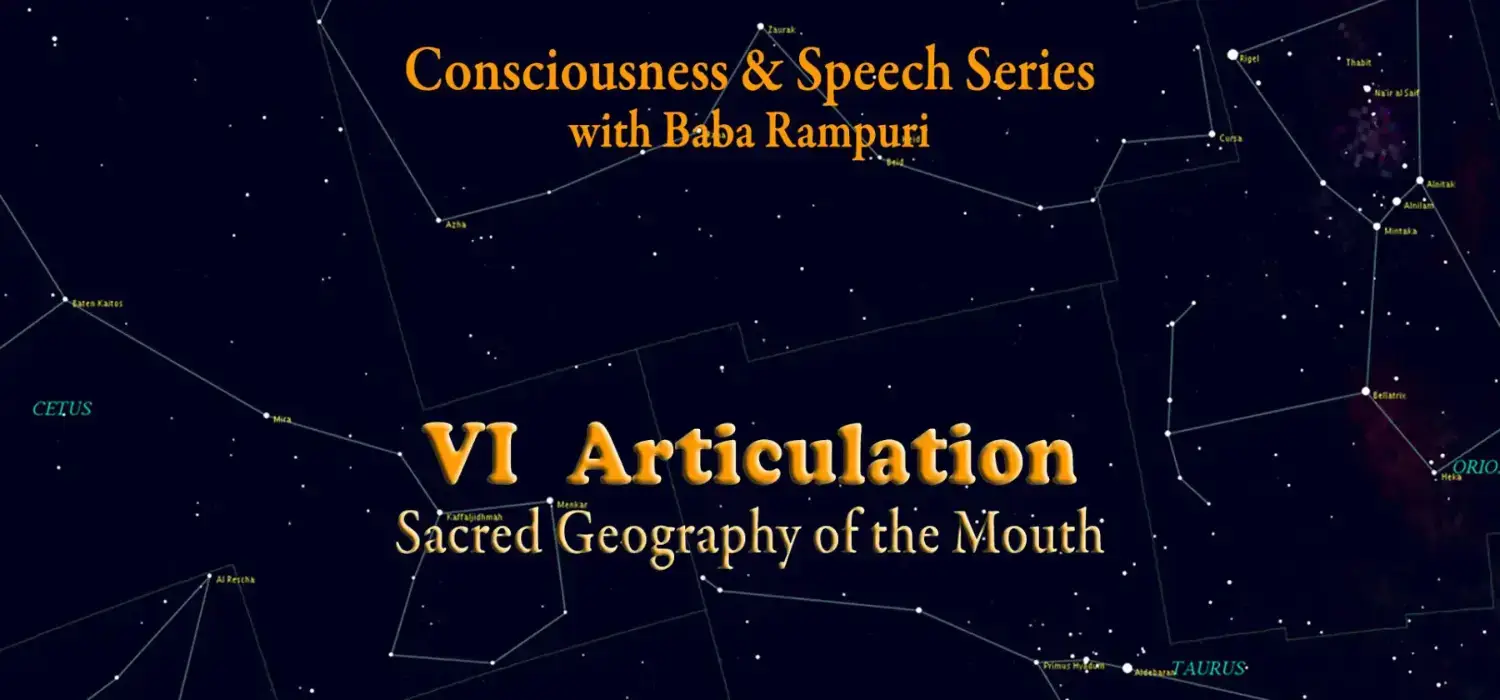
Sacred Geography of the Mouth part 4
Sacred Speech Masterclass episode VI
part 4 of 5 parts
hosted by Baba Rampuri
![]()
Articulation
… what I want you to see is that there are specific points of contact, and specific spaces, because these will become analogs of other things. These will become analogs of the stars in the sky. Of the geography of the earth. Of the elements.
![]()

![]()
Babaji: Now, should we move to the next space, the next station in our vocal apparatus, which among consonants is the Cha varga. Can anybody guess what vowel we are going to find at the cha varga?
Kailash: u?
Babaji: Now. Ok. Here is the exercise you are going to do for the next few weeks with this as we go over syllables. I want you to feel where it is in your mouth that you articulate “oo,’ Kailash. Show me. Pronounce it for me and show me. Everybody look when you pronouce it, Kailash, where is he pronouncing it from. Pronounce it Kailash. “
Kailash: Well, it it being pronounced….. “ooooo” It’s involving the lips
Several people respond: From the lips.
Babaji: Well, there you go. The lips are the “pa” varga. Right?
Kailash: the short “u”
Babaji: “u” and “ū” are both coming from my lips. Right? It’s obvious. So, in other words, what I want you to see is that there are specific points of contact, and specific spaces, because these will become analogs of other things. These will become analogs of the stars in the sky. Of the geography of the earth. Of the elements. And for those of you who have worked a little bit with Kashmira Shaivism with the tantras. All the tantras are analogs of the points of articulation as well.
So.
Michelle: If I move “a” forward, just by doing this “ah-ee- e,” if I push it forward I get “i” kind of, and “i” sound.
Babaji: OK. You are moving in the right direction. That’s absolutely the right direction. So, here we are at the syllable “a.” Now, Shiva has this desire. He wants to know himself. This is kama, desire. And as that desire arises in Shiva, as that calm lake, the still lake of consciousness is disturbed, as if dropping a stone in that calm lake, there is a rise from the first varga, the Ka varga, to the Cha varga, “a” to “i”, not “īi,” because that is giving too much effort, but effortless “i”, I want everyone to try that and feel the movement because this is the very basic movement that starts the universe. “a” to “i”.
Everyone makes sounds.
Babaji: Not “e,” because we will discover in a little while that “e” comes from “a” plus “i”. If you do it together, you get “e.” Right. But we are staying very simple here. We want to articulate the simple vowels without any effort whatsoever. With “a”, when we put effort into “a,” it became “ā”. In the same way, if we put effort into “i”, we get “ī”. As Kailash already mentioned, with the letter “u”, the third of the very important, basic vowels, and we go from “i”, in Sanskrit I think it is the talavya, to “u”, which is the lips… So we have a movement in vowels, “a” to “i” to “u”. Everyone pronounces that or feel that movement.
[Everyone makes sounds.]
Babaji: Not “You”. “a”. “i” . “u”.
I will tell you why, Kailash, you were tempted to say “You” or actually did say “You.” And that is because you were following the vowel “i” with “u” and there is something I have to tell you about these vowels. That, vowels, when they condense, and you can almost say, in fact you can say, that these are the visargas of those vowels, that the vowels become consonants. So we saw how “a” becomes “ha”. But accidently, Kailash found that “i” becomes “ya.” When the vowel “i” condences, contracts, it becomes “ya.”
[Everyone tries saying “ya.”]
Now can anyone tell me what happens to the vowel “u” when that contracts?
Michelle: What consonant?
Babaji: What consonant.
Michelle: Ma?
Babaji: Ok. Well, here’s an easy way to find out. Pronounce “u” and then pronounce “a”.
[Everyone says “Wa”]
Babaji: There you go. You see. What I want you to start seeing with these exercises is that you are not superimposing sounds. And I don’t want you to memorize, at least not yet. I don’t want you to memorize, what vowel, what consonant is where, and this and that, because that’s not the way that this works. The way that it works is that it pre-exists in potential in your vocal apparatus. And if you will explore it, with a map, keeping in mind that the map is not the thing, that you will discover these things on your own, in the same way that you could discover when the vowel “i” condenses or contracts, what consonant does it become well, you put “i” plus “a” and you discovered, I am sorry, you put “u” plus “a” and you discovered “wa.” No because you knew that it was “wa” or because you theorized it was “wa” or memorized it was “wa” but because that is the process of speech itself. And you were able to discover that.
![]()